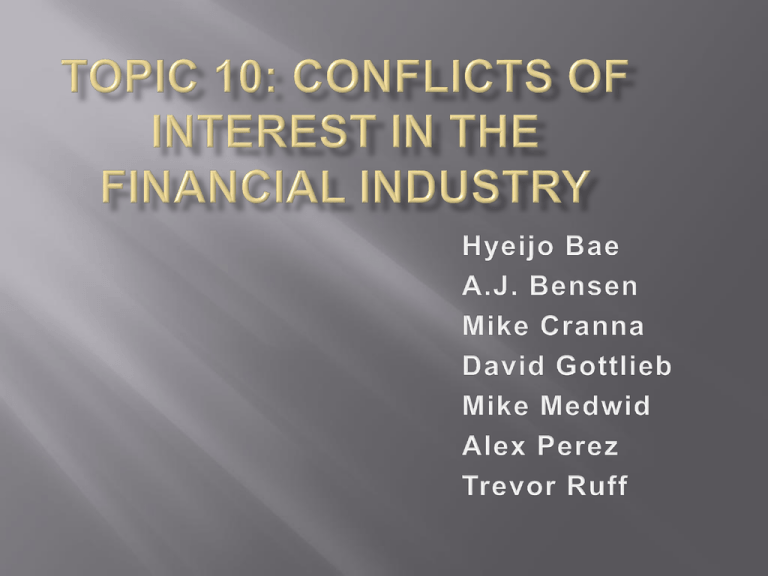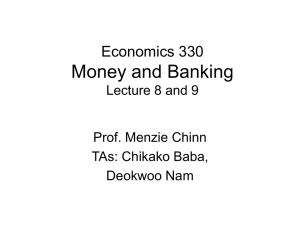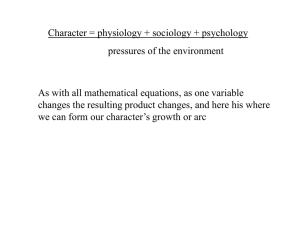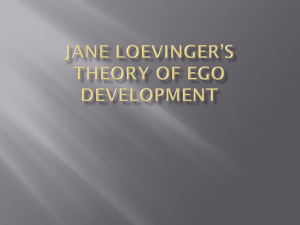Topic 10: Conflicts of Interest in the Financial Industry
advertisement

Conflicts of Interest- a type of moral hazard problem that occurs when a person or institution has multiple objectives (interests) and as a result has conflicts between them. Conflicts of interest usually take the form of misleading information. Financial institutions can benefit off of giving out misleading information, hurting the public, while giving the financial institutions greater profits. Conflicts of interest lead to unethical behavior. Conflicts of interest occur when an institution or employee serves his interests at the expense of others. Combinations of services that bring together any group of depository intermediaries, non-depository intermediaries, and brokers, or that allow any of these groups to invest directly in a business, are most likely to lead to conflicts of interest. Conflicts of interest can substantially reduce the quality of information in financial markets, thereby increasing asymmetric information problems. In turn, asymmetric information prevents financial markets from channeling funds into the most productive investment opportunities and causes financial markets and the economy to become less efficient. The growing economies of scope have led to financial institutions to offer many services under one roof, increasing conflicts of interest and in turn increasing unethical behavior. •Conflicts of interest become a problem for the financial system when they lead to a decrease in the flow of reliable information, either because information is concealed or because misleading information is spread. •The decline in the flow of reliable information makes it harder for the financial system to solve adverse selection and moral hazard problems, which can slow the flow of credit to parties with productive investment opportunities • Inappropriately designed compensation plans, for example may produce conflicts of interest that not only reduce the flow of reliable information to credit markets but also end up destroying the firm. • The conflict of interest problem can become even more hazardous when several lines of business are combined and the returns from one the activities, such as underwriting and consulting, are very high for only a brief amount of time. Also, a compensation scheme that works reasonably well in the short term might become poorly aligned in the long run. Threats to truthful reporting in an audit arise from several potential conflicts of interest. The conflict of interest that has received the most attention in the media occurs when an accounting firm provides its client with auditing services and non-audit consulting services, commonly known as Management Advisory Services, such as advice on taxes, accounting or management information systems, and business strategies Accounting firms that provide multiple services enjoy economies of scale and scope, but have three potential sources of conflicts of interest 1st: clients may pressure auditors into skewing their judgments and opinions by threatening to take their accounting and management services business to another accounting firm 2nd: if auditors are analyzing information systems or examining tax and financial advice put in place by their non-audit counterparts within the accounting firm, they may be reluctant to criticize the advice or systems Both types of conflicts might potentially lead to biased audits With less reliable information available to investors, it becomes more difficult for financial markets to allocate capital efficiently 3rd: arises when an auditor provides an overly favorable audit in an effort to solicit or retain audit business. The unfortunate collapse of Arthur Andersen suggest this may be the most dangerous conflict of interest • • • • • • • In the Arthur Andersen case the partners in regional offices had incentives to please their largest clients even if their actions were detrimental to the firm as a whole Young accountant who founded his own firm Until the early 80’s auditing was the most important source of profits for this firm By late 80’s the consulting part of the business began to experience high revenue growth with high profit margins, even as the audit profits slumped in a more competitive market Consulting partners began to assume more power within the firm, and the resulting conflicts split the firm in two Arthur Andersen and Andersen Consulting were established as a separate company in 2000 During the period of increasing conflict before the split, Andersen’s audit partners had faced increasing pressure to focus on boosting revenue and profits from audit services • • • • • • Largest clients in Regional area included: Enron, WorldCom, Qwest, and Global Crossing The combination of intense pressure to generate revenue and profits from auditing and the fact that some clients dominate the business of regional offices translated into big incentives for regional managers to provide favorable audit stances for these large clients So losing a client such as Enron or WorldCom would be devastating Arthur Andersen ignored many problems in the infamous Enron reporting and became indicted in March 2002 and convicted in June 2002 for obstruction of justice for impeding the SEC’s investigation of the Enron collapse. Its conviction, the first ever against a major accounting firm, barred Arthur Andersen from conducting audits of publicly traded firms and so effectively put it out of business The collapse of Arthur Andersen illustrates how the compensation arrangements for one line of business, such as auditing, can create serious conflicts of interest. •Conflicts of Interest can substantially reduce the quality of information in financial markets, thereby increasing asymmetric information problems. •These asymmetric information problems prevent financial markets from channeling funds into the most productive investment opportunities and causes financial markets and the economy to become less efficient. Analysts in investment banks are persuaded to distort their research to please the underwriting department of their bank and the corporations issuing the securities which undermines the reliability of information investors use for financial decisions and diminishes the efficiency of securities markets. Spinning occurs when investment banks allocate underpriced shares of newly issued stock to executives of other companies in order to lure them to use that investment bank When the executives company plans to issue its own securities it uses that investment bank as an underwriter. This causes a rise in the cost of capital for the firm and hinders the efficiency of the capital market. A bank may make loans to a firm on overly favorable terms to obtain fees from it for performing activities such as underwriting the firms securities A bank with an outstanding loan to a firm whose credit or bankruptcy risk has increased has private knowledge that may encourage the bank to use its under-writing department to sell bonds to the unsuspecting public, thereby paying off the loan and earning a fee. These conflicts of interest decrease the amount of accurate information and hinders the banks ability to promote efficient credit allocation Standard & Poor’s Fitch Ratings Moody’s Corp. Goldman Sachs Rating agencies are paid for their services Agencies may give high paying clients a higher rating Consumers buy bonds and other debt instruments with AAA ratings only to end up losing Example: Fitch Ratings and Standard & Poor’s rated CDO’s issued by Credit Suisse as AAA. Losses on $340 million worth of CDO’s amounted to $125 million Less accurate ratings led to higher profits The combined profits of rating agencies doubled from 3 billion in 2002 to over 6 billion in 2007 Moody’s profits quadrupled between 2000 to 2007 In the first quarter of 2008, 98% of rating changes for CDO’s were downgrades Goldman Sachs Group Inc. is under investigation by the Securities & Exchange Commission for fraud in a mortgage securities transaction. Was there a conflict of interest in this transaction? Goldman Sachs purchased many mortgages from the US housing market. They then converted them into mortgage backed securities. They advised clients to buy these mortgages. At the same time they sold these mortgage securities short as either a hedge against their portfolio to reduce risk or as a major position anticipating a drop in value in the US housing market. Goldman Sachs has an obligation to offer investments that it believe are in the clients best interest. They are also legally obligated to know their client, as well as what is a suitable investment for their client. In this case the clients of Goldman Sachs were knowledgeable investors (i.e. International banks and hedge funds) Did Goldman Sachs disclose, to the clients purchasing these mortgage products, that they were also shorting these same securities? If they did not, Goldman Sachs was acting in their own best interest as opposed to that of their clients. This is a conflict of interest. Goldman Sachs, a premier investment banking firm, may be heavily fined, broken up and/or lose their clients trust, which is Goldman Sachs Group Inc. most valuable asset. Sarbanes-Oxley Act of 2002 Global Legal Settlement of 2002 Four Major Components of SOX 1. Supervisory oversight to monitor and prevent conflicts of interest Establishment of Public Company Accounting Oversight Board (PCAOB) 2. Reduced conflict of interest Unlawful if public accounting firm provide any non-audit service to a client with an impermissible audit 3. Provided incentives for investment banks not to exploit conflicts of interests Criminal charges for white-collar crime and obstruction of official investigation 4. Improved the quality of information in the financial markets CEO, CFO, and auditors are required to certify periodic financial statements and disclosures of the firm Independent members of the audit committee Key elements on the agreement 1. Reduced conflict of interest required to sever the links between research and securities underwriting banned spinning 2. Provided incentives for investment banks not to exploit conflict of interest imposed $1.4 billion of fines on the accused investment banks 3. Had measures to improve the quality of information in financial markets Required investment banks to make public their analysts’ recommendations The existence of a conflict of interest does not mean that it will have serious adverse consequence. Even if incentives to exploit conflicts of interest remain strong, eliminating the economies of scope that create the conflicts of interest may be harmful because it will reduce the flow of reliable information. SARBANES-OXLEY ACT OF 2002 Increased supervisor oversight to monitor and prevent conflicts of interest Directly reduced conflicts of interest Produced incentives for investment banks not to exploit conflicts of interest Instituted measures to improve the quality of information in financial markets GLOBAL LEGAL SETTLEMENT OF 2002 Directly reduced conflicts of interest Produced incentives for investment banks not to exploit conflicts of interest Instituted measures to improve the quality of information in financial markets LEAVE IT TO THE MARKET The market may punish the firm exploiting conflicts of interest by causing them to have higher funding costs or decreased demand for services Open market forces can create means to contain conflicts of interest through information demanded from non conflicted organizations REGULATE FOR TRANSPARENCY Mandatory information disclosure decreases information asymmetries This in turn reveals if conflicts of interest are being exploited Could be bad because of free-loader effect If regulated too much can cause loss in information production and profitability for the firm SUPERVISORY OVERSIGHT Supervisors can review financial information without revealing it to competitors This maintains profitability & information production Supervisors can then take actions to control the exploitation of conflicts of interest and enforce ethical standards SEPARATION OF FUNCTIONS Poor supervisors allow for exploitation to continue Reduces economies of scope through regulation Information sharing between departments is regulated Separates departments and adds firewalls to ensure that the firms agents are not responding to multiple principals Results in a trade off between information production and reducing conflicts of interest Thank You









